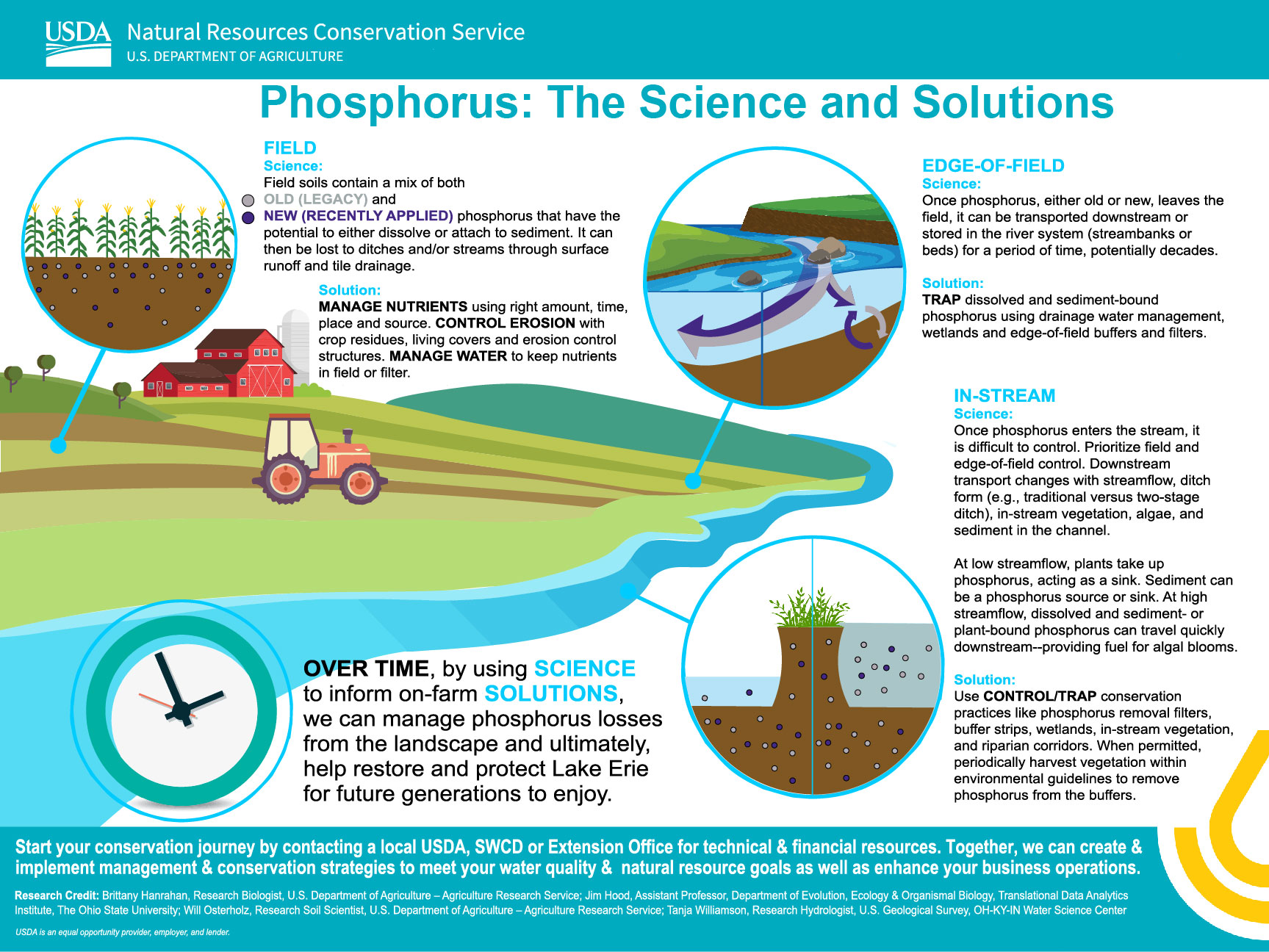Legacy Phosphorus
Significant research and conservation efforts are ongoing across the greater Western Lake Erie Basin to develop and implement strategies to reduce nutrient loading and improve water quality in Lake Erie and other agricultural tributaries. One such particular nutrient getting attention from water quality researchers is phosphorus.
The productivity of soil is largely dependent on the supply of nutrients that become available during the cropping season. Crop growth is affected by the supply of plant available phosphorus in the soil, which is itself determined by the amount of phosphorus in the soil that is soluble in water and the rates of changes to it from other forms of phosphorus in the soil. Because many of Ohio’s soils are deficient in plant available phosphorus, the input of fertilizer and manure is required to optimize crop production. When applied on cropland, a small percentage of applied phosphorus is directly available for crops. Over the growing season, transformations take place in the soil making the remaining soil phosphorus available for the crops. When the added phosphorus is not completely used by the crops, it accumulates in less available forms. This build-up of soil phosphorus is known as legacy-P.
Legacy P can be defined in different ways, as it takes many forms and includes many time frames. It can be recently applied P that has been in the profile long enough to be immobilized. It can be P that was applied years ago and is still stored in the soil and subject to release. It can be P that moved with eroded soil and accumulated at the edge of fields. Or it can be P stored in the stream bed or stream bank system. Additionally, P moves between these various states as water moves it through the system.

Understanding Agricultural Phosphorus Loss Sources
In watersheds dominated by agricultural land use like the Western Lake Erie Basin, dissolved phosphorus losses from agriculture have been shown to represent a concern to water quality. Since 2007, dissolved phosphorus loss from croplands was identified as the primary cause of more frequent and intense algal blooms in Lake Erie. Since then, farmers and researchers continue to evaluate the sources and mechanisms of agricultural phosphorus losses and control.
For example, in a recent analysis by the USDA-ARS Soil Drainage Research Unit, and through using edge-of-field monitoring equipment, it was found that broadcasting liquid manure showed the highest rate of phosphorus loss when compared to other manure application methods like incorporating or injecting liquid manure into the soil.
By identifying high-risk phosphorus loss sources, farmers can in turn determine which management practices are best for mitigating nutrient loss from newly applied fertilizer. But what about reducing legacy-P?
Legacy Phosphorus vs. Newly Applied Phosphorus
“When mobilized, either through surface runoff or subsurface tile drainage, legacy phosphorus can get released into the land-to-freshwater transport continuum, acting as a continuing source of phosphorus to downstream water bodies for years, decades, or even centuries,” said Aaron Heilers, former Project Manager at Blanchard River Demonstration Farms Network. “Addressing the source and transport processes of legacy phosphorus is critical to helping farmers make better nutrient management decisions.”
Agricultural phosphorus loss sources can be approximately divided into two categories, those derived from legacy-P and those derived from newly applied phosphors such as fertilizer. Differentiating between newly applied phosphorus and legacy-P allows researchers to account for total agricultural phosphorus losses.
In an analysis from the Ohio USDA–ARS Edge-of-Field Monitoring Network, data indicates that legacy-P contributes to 80% of phosphorus loss, and newly applied phosphorus, from that of either chemical fertilizer or manure, contributes to the remaining 20% of phosphorus loss.
Also important is recognizing the pathways of phosphorus loss from croplands. Surface runoff caused by rain events and erosion are well-recognized pathways of phosphorus loss. However, subsurface tile drainage is also identified as a primary pathway of phosphorus loss, accounting for over 60% of losses. These two dynamics and interrelated but conflicting processes, complicate strategies to change farm management to manage phosphorus loss.
Managing Legacy Phosphorus
There are numerous ways to manage general nutrient loss as it is released from croplands. One practice-based framework is the USDA–NRCS’s Avoid, Control, and Trap (ACT) conservation approach.
This approach uses conservation practices to avoid loss, control transport, and trap lost soil resources and nutrient inputs. Avoiding practices would include nutrient management and the 4-R’s. Controlling practices include conservation tillage and cover crops. Trapping practices include buffer strips, wetlands, and riparian zone management. These practices help farmers reduce nutrient loss by lessening the amount of soil, nutrient and pesticide inputs leaving the field.
Management practices specifically known to reduce the loss of legacy-P are less known. In a first known study of its kind, researchers from the USDA-ARS Soil Drainage Research Unit, The Ohio State University and Iowa State University, are beginning to evaluate the source contributions of legacy-P and newly applied phosphorus through edge-of-field data.
To learn more about the conservation practices improving agriculture’s impact on downstream water quality in Ohio, visit the Practices page.


